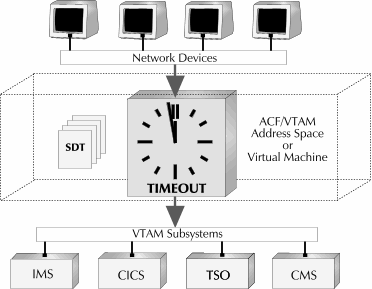
Timeout is a member of the Network Center, a family of software components that operate independently or together in the system 390 environment to provide you with the power to manage, monitor, and control VTAM based networks.
Note: Other Components include Compress, Access, Alias, Query, Trace, and Select. [See the Components individual manuals for more information. ] To find out which Components are installed at your installation, contact the Network Administrator (the person responsible for installing and configuring the Network Center).
Note: The General Information Manual (TNC-0001) also contains information on the architecture of the Network Center and its Components.
Unattended terminals can lead to security violations and waste valuable system resources. Timeout solves this problem by allowing you to create Rules that automatically terminate inactive or active VTAM [VTAM is a key component of an SNA based network and handles a wide variety of tasks associated with an operating network of devices, users, and applications. At each installation, the Network Administrator controls the type of processing VTAM undertakes via a series of definitions and activities within in VTAM (VTAMLST definitions, etc.). ] sessions based on conditions such as maximum connect time, time-of-day, or idle time intervals. Timeout can help you build a more efficient, secure, and accessible network.
Timeout can also reduce unnecessary VTAM sessions, enforce an installation specified inactivity timer across all VTAM subsystems, and generally guarantee that a single SNA host processor is used under approved conditions. You define the conditions under which specific timeout values are to be used. If no Rule exists setting a timeout interval, then Timeout will not timeout the session.
Because Timeout eliminates inactive VTAM sessions, it reduces network overhead and frees hardware resources for other uses. This is particularly beneficial for implementations such as LANs, dial up configurations, or other pooled situations.
When VTAM executes, it processes requests for sessions between two LUs (logical units). If a session is established, it allows information to be transferred between a terminal device and a processing subsystem - such as CICS, TSO, VSCS, IMS, ROSCOE, IDMS, MODEL204, and NETVIEW - or between two programs. All interactive session transmissions passed between the device and the subsystem travel through VTAM itself.
Timeout provides a VTAM level timeout facility that is independent of the processing subsystem. It does not disrupt any timing facilities that may be active within a subsystem, but adds a timing facility at the network level. Timeout allows you to define Rules that control the local domain's activity levels.
The following figure illustrates how Timeout operates in a network:

|
Timeout asynchronously monitors VTAM's session activity by periodically reflecting the activity in the SDT (Session Directory Table). If a specific session violates the active Rules, Timeout generates the appropriate VTAM VARY command in the form "VARY TERM,SID=" to terminate the session.